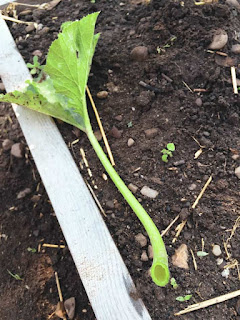You probably think you already know how to grow a zucchini but if you live in North America … you might not. Here’s the way to grow zucchini to make your plants last longer, take up less space and produce more.
First off, this post has been shared half a million times. Why? Because it’s GREAT information on something we are all doing wrong.
Secondly … why would you want your zucchini plants to produce more, you’re asking? Because of the obvious. They’re fun to throw through people’s open car windows during zucchini season.
Zucchini are one of those vegetables that already produce more than you ever expect them to and seem relatively easy to grow. And they are. But you can do a MUCH better job of growing them if you’re aware of these 3 surprising things about zucchini plants.
Most surprising of all is the fact that Zucchini can perform complex math equations.
No they can’t.
Zucchini Growing Tips
Zucchini need to be pruned and staked. For real. Like a tomato.
Zucchini can be planted VERY close together. 1 per square foot.
Powdery Mildew CAN be halted. O.K., maybe not entirely halted but slowed wayyyyy down.
Pruning and Staking Zucchini
The only other plant in my garden that I prune more than my zucchini are my tomato plants. Just like tomatoes, zucchini benefit hugely from pruning. They’ll be susceptible to less disease, have a more open formation that allows easier access for bees to pollinate and they’ll take up less space.
Staking
It’s best to stake your zucchini when you first plant it, but you can still do it during the growing season.
Plant a stake right next to the main stem of the zucchini plant. I use coated metal stakes. You may not have noticed it before, but zucchini all come from one stem. That stem is just usually sprawled and dirty on the ground covered in decaying leaves. So you can’t get a good look at it.
But trust me. Zucchini have one stem, that can be staked just like a tomato.
The earlier you do it the easier it is though.
Pruning
You can remove ALL OF THE LEAVES FROM THE STEM THAT ARE BELOW THE LOWEST ZUCCHINI. If you don’t already, you have to start trimming your zucchini plants.
Zucchini leaf stems are hollow UNTIL they get to the stem of the plant. There they turn solid again. Prune your zucchini leaves right up to the stem of the plant so you don’t have any of the hollow stem left.
See the difference from the left photograph and the right one?
WHY PRUNE?
The developing zucchini gain all their energy from ONLY the leaves growing above them. The leaves below, are just taking energy away from the rest of the plant.
Pruning away diseased and damaged leaves helps prevent and slow powdery mildew by creating greater air circulation.
Pruning away the larger, lower leaves that aren’t contributing to the plant means you can plant more zucchini in a smaller space.
Spacing Zucchini
Most guides tell you to place zucchini plants at least 24″ apart. You don’t need that much room between them.
Plant zucchini 1′ apart in 1.5″ rows.
If you’re staking them and pruning them this is all the room they need.
Here you can see pre-pruning and staking …
And below you can see post pruning and staking.


























